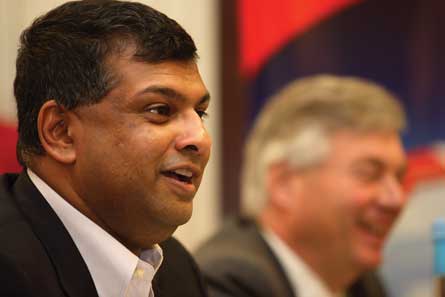The recent launch of several long-haul low-cost players has sparked intense debate about how fast this model can penetrate the established network carrier order. Is it a niche phenomenon or something more mainstream?
They call it the silly season in media circles - a time that coincides with a holiday period when hard news is hard to come by. So it was with glee in the first days of January that journalists jumped on the story that a Malaysian entrepreneur was going to start a long-haul budget carrier offering fares from just $80 between Kuala Lumpur and the UK. Even more intriguingly, the new entrant was going to link up with European low-cost carriers. It was the genesis of a global network of low-fare players.
|
|---|
"I don't think you'll ever see a Star Alliance of budget airlines" Tony Fernandes, chief executive, AirAsia. |
For Tony Fernandes, the ebullient founder of AirAsia, his idea to create a long-haul carrier is far from frivolous. And he has been exploring whether links between his brainchild - called AirAsia X - and Europe's low-fare giants will be possible. His proposition for Ryanair's Michael O'Leary and easyJet's Stelios Haji-Ioannu was: sell AirAsia and AirAsia X on your website and in turn I'll sell easyJet or Ryanair on mine.
O'Leary and Stelios have not yet accepted the offer, made late last year as Fernandes drafted his business plan for a long-haul low-cost carrier. O'Leary says he is not interested and while it is believed Stelios considered the idea, the easyJet board apparently concluded the tie-up would dilute its model.
Fernandes is not put off. He envisages low-cost carriers around the world ultimately partnering to package flights rather than inking interline agreements or formal alliances. Passengers will have to make connections "at their own risk" and "check out and check in" at the connecting city. He thinks website tie-ups are a good way to co-operate "without bastardising the model".
There are examples in other markets, with Air Berlin linking with affiliates like Austria's Niki and DBA in Germany, while AirTran and Frontier have a new marketing deal enabling them to cross-sell. However, there are risks. The amount of revenue website tie-ups may add is questionable and there is the possibility for traveller confusion with passengers assuming the selling airline is responsible or will guarantee to connect with the partner airline.
More formal interline deals were studied by Fernandes, but he concluded they are too complex and costly for low-cost carriers (see related story on page 52). He also does not think alliances are a good idea in the low-cost industry. "There is no need for robust alliances," he says. "I don't think you'll ever see a Star Alliance of budget airlines."
The chance for low-cost carrier partnerships only arises because the low-cost industry has started branching into the long-haul sector. For years, most industry pundits said long-haul low-cost could not work. In fact, network and leisure carriers already offer thousands of low-fare tickets. And until late last year there were no pure long-haul low-cost airlines. Now there are three - Jetstar, Oasis Hong Kong Airlines and Viva Macau. AirAsia X, Virgin Blue and possibly several others will soon follow.
Even low-cost purist O'Leary seems willing to muddy the traditional model with his bid to take over Irish flag carrier Aer Lingus. That bid has stalled for now, and does not mean Ryanair is tempted by long-haul low-cost. "I think people will try it," says O'Leary. "But I don't think it will be successful over the long term."
O'Leary and others say legacy carriers have a huge advantage over low-cost carriers in long haul, especially the Asia-Europe market, as premium business accounts for 20% of their traffic and proportionally more of their profit.
Jetstar, Oasis and Viva Macau have two classes, as will AirAsia X, but they will not have the high-yield traffic network carriers enjoy. Without this, low-cost long-haul players may struggle on a diet of cheap point-to-point traffic.
But Fernandes thinks the fact that Asia's legacy carriers are focusing more on the premium market, with new business- and first-class seats, creates an opportunity. "Airlines are trying to go more upmarket," he says. "I feel lost in the Singapore Airlines business-class seat, it is so wide."
The AirAsia X experiment is one several investors are willing to try. But unless a bright spark can work out how to cost-effectively connect them to the short-haul low-cost world, for now their attempts are likely to remain in a niche rather than in a network future.
Source: Airline Business

















